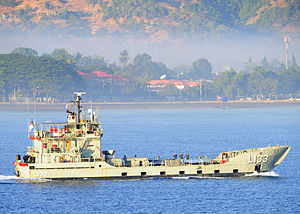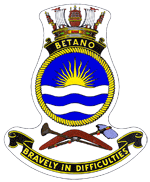Loading AI tools
From Wikipedia, the free encyclopedia
HMAS Betano (L 133) was a Balikpapan-class heavy landing craft operated by the Royal Australian Navy (RAN).
 HMAS Betano in June 2011 | |
| History | |
|---|---|
| Builder | Walkers Limited |
| Laid down | September 1972 |
| Launched | 5 December 1972 |
| Commissioned | 8 February 1974 |
| Decommissioned | 12 December 2012 |
| Homeport | HMAS Coonawarra |
| Motto | "Bravely In Difficulties" |
| Honours and awards |
|
| Status | Awaiting disposal |
| Badge |  |
| General characteristics | |
| Class and type | Balikpapan-class landing craft heavy |
| Displacement | 316 tons |
| Length | 44.5 m (146 ft) |
| Beam | 10.1 m (33 ft) |
| Propulsion | Two GE diesels |
| Speed | 9 knots (17 km/h; 10 mph) |
| Capacity | 180 tons of vehicle cargo or 400 soldiers |
| Complement | 13 |
| Armament | 2 × 0.50 inch machine guns |
The eight-vessel Balikpapan class was ordered as a locally manufactured replacement for the Australian Army's LSM-1-class landing ship medium and ALC 50 landing craft.[3] They are 44.5 metres (146 ft) long, with a beam of 10.1 metres (33 ft), and a draught of 1.9 metres (6 ft 3 in).[4] The landing craft have a standard displacement of 316 tons, with a full load displacement of 503 tons.[4] They are propelled by two G.M. Detroit 6-71 diesel motors, providing 675 brake horsepower to the two propeller shafts, allowing the vessels to reach 9 knots (17 km/h; 10 mph).[4] The standard ship's company is 13-strong.[4] The Balikpapans are equipped with a Decca RM 916 navigational radar, and fitted with two 7.62 millimetres (0.300 in) machine guns for self-defence.[4]
The LCHs have a maximum payload of 180 tons; equivalent to 3 Leopard 1 tanks, 13 M113 armoured personnel carriers, 23 quarter-tonne trucks, or four LARC-V amphibious cargo vehicles.[4][5] As a troop transport, a Balikpapan-class vessel can transport up to 400 soldiers between a larger amphibious ship and the shore, or embark 60 soldiers[6] in six-berth caravans for longer voyages.[5] The vessel's payload affects the range: at 175 tons of cargo, each vessel has a range of 1,300 nautical miles (2,400 km; 1,500 mi), which increases to 2,280 nautical miles (4,220 km; 2,620 mi) with a 150-ton payload, and 3,000 nautical miles (5,600 km; 3,500 mi) when unladen.[4] The flat, box-like keel causes the ships to roll considerably in other-than-calm conditions, limiting their ability to make long voyages.[5]
Betano was laid down by Walkers Limited at Maryborough, Queensland on 3 October 1972, launched on 12 December 1972, and commissioned into the RAN on 8 February 1974.[7]
In April 1974, Betano, Buna, and Brunei transited to Lord Howe Island as a demonstration of the Balikpanan class' oceangoing capabilities.[8]
Following the destruction of Darwin by Cyclone Tracy during the night of 24–25 December 1974, Betano was deployed as part of the relief effort; Operation Navy Help Darwin.[9] Betano sailed from Brisbane on 26 December.[9]
From 1985 to 1988, Betano and Brunei were assigned to the Australian Hydrographic Officer and operated as survey ships in the waters of northern Australia and Papua New Guinea.[8]
The ship was deployed to East Timor as part of the Australian-led INTERFET peacekeeping taskforce from 19 January to 19 February 2000.[10] Her service earned her the battle honour "East Timor 2000".[1][2]
Betano was decommissioned at Darwin on 12 December 2012.[11][12] The Philippine Navy has shown interest in acquiring the ship after the Australian government donated two sister ships, HMAS Brunei and HMAS Tarakan in 2015.[13][14] It was later confirmed that the Philippine Navy will acquire three more LCHs from Australia, including ex-HMAS Betano, at a token price.[15]
Seamless Wikipedia browsing. On steroids.
Every time you click a link to Wikipedia, Wiktionary or Wikiquote in your browser's search results, it will show the modern Wikiwand interface.
Wikiwand extension is a five stars, simple, with minimum permission required to keep your browsing private, safe and transparent.